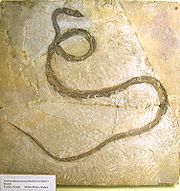
Monte Bolca
Encyclopedia

Monte Bolca is a lagerstätte
Lagerstätte
A Lagerstätte is a sedimentary deposit that exhibits extraordinary fossil richness or completeness.Palaeontologists distinguish two kinds....
near Verona, Italy
Italy
Italy , officially the Italian Republic languages]] under the European Charter for Regional or Minority Languages. In each of these, Italy's official name is as follows:;;;;;;;;), is a unitary parliamentary republic in South-Central Europe. To the north it borders France, Switzerland, Austria and...
that was one of the first fossil sites with high quality preservation known to Europeans, and is still an important source of fossils from the Eocene
Eocene
The Eocene Epoch, lasting from about 56 to 34 million years ago , is a major division of the geologic timescale and the second epoch of the Paleogene Period in the Cenozoic Era. The Eocene spans the time from the end of the Palaeocene Epoch to the beginning of the Oligocene Epoch. The start of the...
.
Strictly speaking, the Monte Bolca site is one specific spot near the village of Bolca in Italy, known as the Pesciara ("The Fishbowl") due to its many extraordinarily well preserved Eocene fish fossils. However, there are several other related outcroppings in the general vicinity that also carry fossils, such as Monte Postale and Monte Vegroni. The term Monte Bolca is used interchangeably to refer to the one, original site, or to all the sites collectively.
Monte Bolca was uplifted from the ocean floor during the formation of the Alps
Alps
The Alps is one of the great mountain range systems of Europe, stretching from Austria and Slovenia in the east through Italy, Switzerland, Liechtenstein and Germany to France in the west....
, in two stages: one 24 million years ago, and one between 30 and 50 million years ago. The entire formation consists of 19 metres of limestone, all of which contain fossils, but interspersed in which are the lagerstatten layers that contain the highly preserved specimens.
Within these layers, the fish and other specimens are so highly preserved that their organs are often completely preserved in fossil form, and even the skin colour can sometimes be determined. The normal rearrangement of the specimens caused by mud-dwelling organisms in the layer before it turned to stone has been avoided -- it is assumed that the mud in question was low in oxygen, preventing both decay and the action of scavengers.
The fossils at Monte Bolca have been known since at least the 16th century, and were studied intensively in the 19th century once it was definitively proven that fossils were the remnants of dead animals.
Fossils from Monte Bolca are commonly available for sale by commercial fossil dealers, and due to their popularity and preservation regularly sell for several hundred dollars.
Fossil species include the moonfish Mene rhombea
Mene rhombea
Mene rhombea was a perciform fish found in the Tethys Ocean during the Eocene . As suggested by their fossils' small, upturned mouths, and by comparison of its living relative, M. maculata, M. rhombea was a planktivore. Their fossils from the laggerstat Monte Bolca are greatly valued....
and Mene oblonga
Mene oblonga
Mene oblonga is a species of perciform fish that first appeared in the Monte Bolca Lagerstatten during the Lutetian epoch of the Eocene. For a menid, it has a very shallow body, especially in comparison with the sympatric Mene rhombea. Its fossils are very rare in Monte Bolca. A single fossil...
, the batfish
Batfish
Batfish is a name given to several fishes:* The California batfish or sting ray .* Some members of the family Ephippidae.* Some members of the family Ogcocephalidae, including the Pancake batfish.and:...
Eoplatax papilio, the spadefish Exellia velifer, a crocodile
Crocodile
A crocodile is any species belonging to the family Crocodylidae . The term can also be used more loosely to include all extant members of the order Crocodilia: i.e...
, Crocodilus vicetinus, and a snake, Archaeophis bolcaensis.

